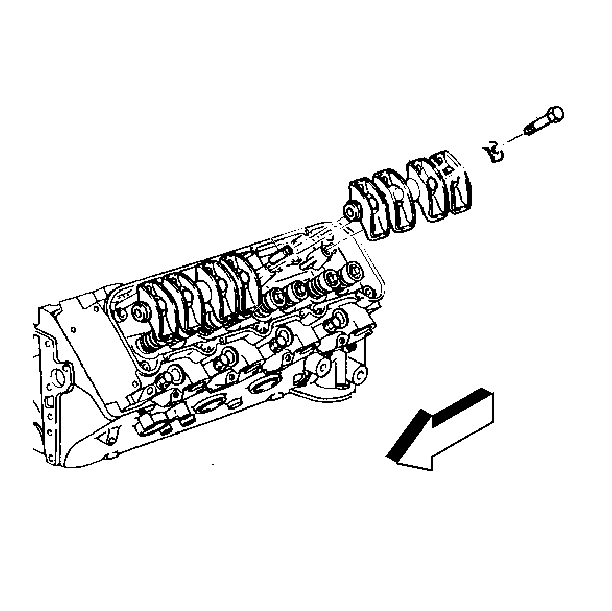Removal Procedure
- Remove the valve rocker arm cover. Refer to Valve Rocker Arm Cover Replacement .
- Remove the valve rocker arm shaft bolts.
- Remove the valve rocker arm shaft with the valve rocker arms.
- Remove the pushrods.
- Remove the valve rocker arms, if required.
- Insert a screwdriver into the valve rocker arm shaft bore and break off the end of the nylon valve rocker arm retainers.
- Remove the valve rocker arm retainers with a pair of pliers.
- Slide the valve rocker arms from the shaft.
- Inspect each of the following components:

Important:
• Rotate the engine until the mark on the crankshaft balancer is
at 2 o'clock. • Rotate the crankshaft counterclockwise 88 mm (3 1/2
in), aligning the crankshaft balancer mark with the first lower water pump
bolt, about 12:30. • This will position the engine so no valves are close to a piston
crown.
Notice: All valve train components must be reassembled in the exact order and position from which they were removed.
Important: The pushrods must be installed in the original direction as disassembly. This is because the pushrods have a different degree of hardness at each end. A paint stripe identifies the upper end of the pushrod. If the paint stripe is not visible, mark the pushrods on the upper end as they are removed.

| • | Inspect the valve rocker arms and the shafts at their mating surfaces. These surfaces should be smooth and free from scoring or other damage. |
| • | Inspect the valve rocker arm areas which contact the valve stems and the sockets which contact the pushrods. These areas should be smooth and free of damage and wear. |
| • | Inspect the pushrods for bending. Roll the pushrod on a flat surface to determine if the pushrod is bent. Replace the pushrod if necessary. |
| • | Inspect the ends of the pushrods for scoring or roughness. |
| • | Inspect the valve lifter guides and the retainers. |
| • | Inspect the oil passages in the pushrods for obstructions. The pushrod oil passages must be clean. |
Installation Procedure
- Install the valve rocker arms to the valve rocker arm shaft. One type of valve rocker arm is used at all locations.
- Install the valve rocker arm retainers.
- Center the valve rocker arms on the corresponding holes in the valve rocker arm shaft.
- Install the new retainers. Use a drift of at least 13 mm (1/2 in) in diameter.
- Install the pushrods, with the painted or marked end up.
- Install the valve rocker arm shaft assembly.
- Install the valve rocker arm shaft bolts.
- Install the valve rocker arm cover.
Notice: All valve train components must be reassembled in the exact order and position from which they were removed.
Important: Lubricate the valve rocker arms with clean engine oil before installing.

Notice: Install the valve pushrods with the marked or painted end up in order to avoid damage or premature wear.

Notice: Improper installation of the valve rocker arm shaft bolts may cause valve rocker arm shaft breakage and piston to valve contact.
Important: Make sure the ball ends of the pushrods seat in the valve rocker arms.
Tighten
Tighten the bolts alternately to 55 N·m (40 lb ft).
Rotate the engine by hand in order to ensure free movement of the valve train.
Notice: Use the correct fastener in the correct location. Replacement fasteners must be the correct part number for that application. Fasteners requiring replacement or fasteners requiring the use of thread locking compound or sealant are identified in the service procedure. Do not use paints, lubricants, or corrosion inhibitors on fasteners or fastener joint surfaces unless specified. These coatings affect fastener torque and joint clamping force and may damage the fastener. Use the correct tightening sequence and specifications when installing fasteners in order to avoid damage to parts and systems.
